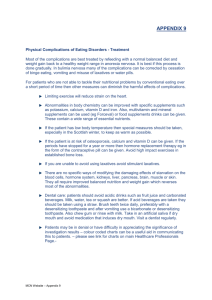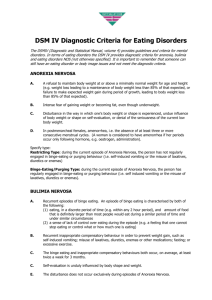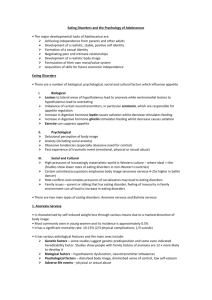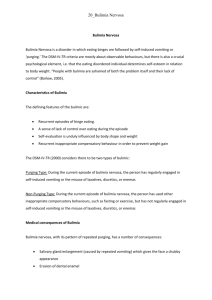Clinical Assessment: Nutritional Status Guide
advertisement
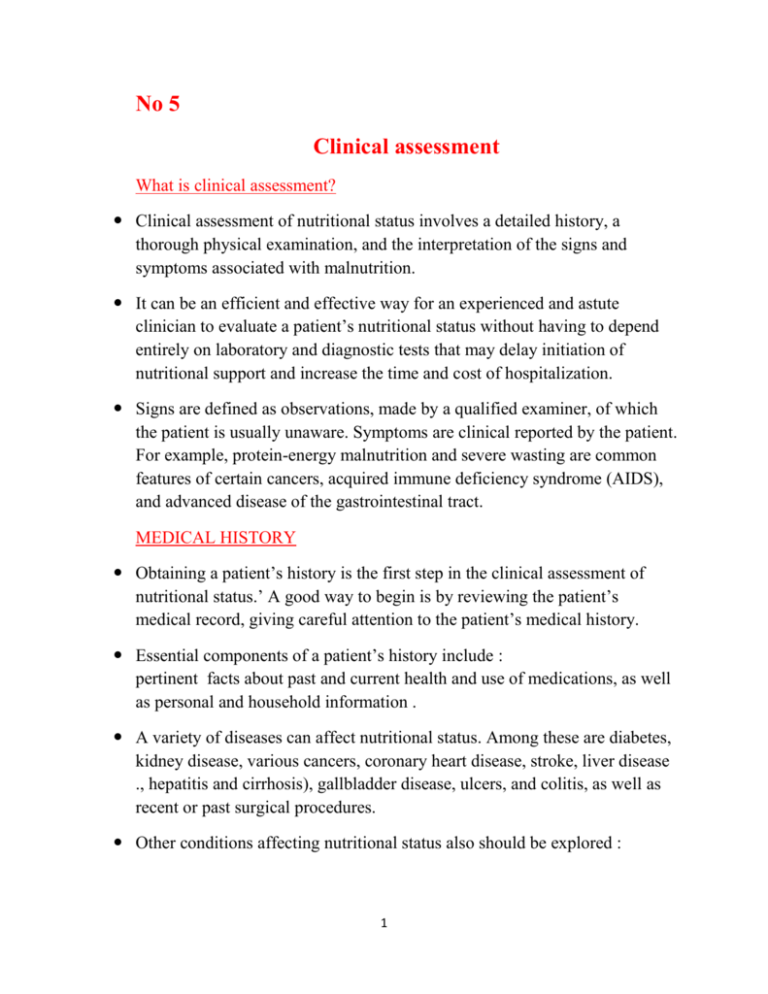
No 5 Clinical assessment What is clinical assessment? Clinical assessment of nutritional status involves a detailed history, a thorough physical examination, and the interpretation of the signs and symptoms associated with malnutrition. It can be an efficient and effective way for an experienced and astute clinician to evaluate a patient’s nutritional status without having to depend entirely on laboratory and diagnostic tests that may delay initiation of nutritional support and increase the time and cost of hospitalization. Signs are defined as observations, made by a qualified examiner, of which the patient is usually unaware. Symptoms are clinical reported by the patient. For example, protein-energy malnutrition and severe wasting are common features of certain cancers, acquired immune deficiency syndrome (AIDS), and advanced disease of the gastrointestinal tract. MEDICAL HISTORY Obtaining a patient’s history is the first step in the clinical assessment of nutritional status.’ A good way to begin is by reviewing the patient’s medical record, giving careful attention to the patient’s medical history. Essential components of a patient’s history include : pertinent facts about past and current health and use of medications, as well as personal and household information . A variety of diseases can affect nutritional status. Among these are diabetes, kidney disease, various cancers, coronary heart disease, stroke, liver disease ., hepatitis and cirrhosis), gallbladder disease, ulcers, and colitis, as well as recent or past surgical procedures. Other conditions affecting nutritional status also should be explored : 1 the ability to chew and allow ; appetite; and the presence of vomiting. diarrhea, constipation, flatulence, belching , or indigestion. An inquiry should be made about the patient’s usual weight and any recent changes (gains or losses) in weight. Information on the use of medications will provide clues about the patient’s actual or perceived medical condition. This will include prescription and over-the –counter medications , vitamin and mineral supplements, nontraditional medications, such as herbal and folk remedies. This information can also be helpful in identifying drug-nutrient interactions potentially having an adverse effect on the patient’s nutritional status. Psychosocial factors include the patient’s age; occupation; educational level; marital status; income; living arrangements; number of dependents; use of alcohol, tobacco, and illicit drugs; degree of social and emotional support; and access to and ability to pay for health care. The necessary detail of the history will vary depend- on circumstances and will be influenced by the patient’s ability to respond to questioning. In some instances, the necessary information might need to be Lined from a surrogate (a parent, a companion, a sibling, or another person knowledgeable about the patient’s habits). Much of this information can be obtained a history and physical examination performed by admitting physician, from the notes of nurses or social workers, and from previous medical records. DIETARY HISTORY Included with the dietary history is information about the patient’s eating practices. This includes a wide range of information about usual eating patterns (timing and location of meals and snacks), food preferences and aversions, intolerances and allergies, amount of money available for purchasing food, ability to obtain and prepare food, eligibility for and access to food assistance programs, and use of vitamin, mineral, and other supplements. 2 Factors to consider in Taking a patients Dietary history Weight changes Usual meal pattern Appetite Satiety Discomfort after eating Chewing/swallowing ability Likes/dislikes Taste changes/aversions Allergies Nausea/vomiting Bowel habits-—diarrhea, constipation. steatorrhea Living conditions Snack consumption Vitamin/mineral supplement use Alcohol/drug use Previous diet restrictions Surgery/chronic diseases Ability to purchase and prepare food Access to and ability to pay for health care 3 For example, when inquiring about appetite, satiety, or discomfort, it is important to ask if the patient has experienced any changes in desire for food, if he or she experiences satiety earlier or later than usual, and if there is any pain or discomfort associated with eating. Questions about the ability to chew and swallow food are important. Are there dental or oral problems making it difficult to chew certain foods or to consume adequate energy to support normal body weight? If the patient wears dentures, are they well fitting? If swallowing is painful or difficult, for what foods? Questioning the patient about bowel habits can often provide information pertinent to the diagnosis of gastrointestinal disease. The patient should be asked about changes in bowel habits, such as constipation, diarrhea, or unusual amounts of flatus (gas), and about stool consistency and color. Obviously, the presence of bright red blood in the stool is an important finding. Stools containing digested blood (e.g., from a Needing peptic ulcer) may appear black or tarry. The finding of frothy, watery, and foul-smelling stools suggests the possibility of fat malabsorption. SUBJECTIVE GLOBAL ASSESSMENT Subjective Global Assessment (SGA) is a clinical technique for assessing the nutritional status of a patient based on features of the patient’s history and physical examination). Unlike traditional methods that rely heavily on objective anthropometric and biochemical data, SGA is based on four elements of the patient’s history (recent loss of body weight, changes in usual diet, presence of significant gastrointestinal symptoms, and the patient’s functional capacity). Elements of the History The first of the four elements of the SGA history is the percent and pattern of weight loss within 6 months prior to examination. A weight loss < 5% is considered small. A 5% to 10%weight loss is considered potentially 4 significant . A weight loss > 10% is considered definitely significant. The pattern of weight loss is also important. Dietary intake, the second element of the history, is classified as normal (i.e., what the patient usually eat)or abnormal(i.e., a change from the patient’s usual diet). If intake is abnormal, the duration in weeks is entered, and the appropriate box is checked to indicate type of dietary intake abnormality (i.e., increased intake, suboptimal solid, full-liquid, IV or hypocaloric liquids, or starvation).. The patient can be asked if the amount of food consumed has changed and, if so, by how much and why. If the patient is eating less, it would be valuable to know what happens when he or she tries to eat more. Ask for a description of a typical breakfast, lunch and dinner and how that compares with what the eat typically ate 6 or 12 months ago. Information about any gastrointestinal symptoms persisting more than 2 weeks (the third history element) should be elicited and noted on the form. Diarrhea or occasional vomiting lasting only a few days is not considered significant. The presence or absence of any dysfunction in the patient’s ability to attend to activities of daily living (the last history element) should also be noted on the form. If a dysfunction is present, its duration and type should be noted. Elements of the Physical Examination The first of the three elements of the physical examination is loss of subcutaneous fat. The four anatomic areas are(shoulders, triceps, chest, and hands) should be checked for loss of fullness or loose-fitting skin, although the latter may appear in older persons who are not malnourished. Illustrations of subcutaneous fat loss in the arm, chest wall, and hands are shown below. Loss of subcutaneous fat should be noted as normal (0), mild loss (1+), moderate loss (2+). or severe loss (3+), According to Detsky, the presence of muscle wasting (the second element of the physical examination) is best assessed by examining the deltoid muscles 5 (located at the sides of the shoulders) and the quadriceps feruoris muscles (the muscles of the anterior thigh). According to Detsky, the presence of muscle wasting (the second element of the physical examination) is best assessed by examining the deltoid muscles (located at the sides of the shoulders) and the quadriceps femoris muscles (the muscles of the anterior thigh). Loss of subcutaneous fat in the shoulders and deltoid muscle wasting gives the shoulders a squared-off appearance, similar to that shown below. These areas can be assessed as being normal or mildly, moderately, or severely wasted. The presence of edema at the ankle or sacrum can also be assessed as absent, mild, moderate, or severe, The presence of “pitting” edema can be checked by momentarily pressing the area with a finger and then looking for a persistent depression (more than 5 seconds) where the finger was. Ankle edema and ascites can be assessed as absent, mild, moderate, or severe. When considerable edema or ascites are present, weight loss is a less important variable. PROTEIN-ENERGY MALNUTRITION Clinical Signs In its most severe states, protein-energy malnutrition (PEM) takes the form of kwashiorkor or marasmus .Kwashiorkor is predominantly a protein deficiency. whereas marasmus is mainly an energy deficiency. Kwashiorkor is characterized by a relatively normal weight, generally intact skeletal musculature, and decreased concentrations of serum proteins. A common feature is soft, pitting, painless edema in the feet and legs, extending into the perineum, upper extremities, and are cases. The hair can become dry, brittle, easily pulled out without pain. The marasmic patient typically presents with significant loss of body skeletal muscle, and adipose tissue mass but with serum protein concentrations relatively intact. 6 Patients are often seen at 60% or less of their expected weight for height, and marasmic children have a reduction in their longitudinal growth. Patients are described as having a “skin and bones” appearance. Differences in clinical signs between kwashiorkor and marasmus Other clinical signs of PEM include the “flag sign” and growth failure. In the flag sign, there are alternating bands of depigmented and normal-colored hair produced by alternating periods of poor and relatively good protein intake. Hair grown during periods of poor protein intake can become depigrnented and turn a dull brown, red, or even yellowish white. Hair grown during periods of more adequate protein intake returns to its normal color, The flag sign is especially noticeable in persons with long, dark-colored hair. An example of the flag sign is shown below. Growth failure (or failure to thrive) is the most common sign of malnutrition in children. It is a failure to gain weight and height at the expected rate. Growth failure can result from one or any combination of factors, such as inadequate nutrient intake, nutrient malabsorption, failure to utilize nutrients, increased nutrient losses, and increased nutrient requirements. Major contributing factors to growth failure include poverty, inadequate emotional and social nurturing, and infections, especially parasitic gut infestations. Human Immunodeficiency Virus Infection . Nutritional alterations are common in persons infected lie human immunodeficiency virus (HIV), the scot acquired immunodeficiency syndrome, or AIDS. Before the development of HIV antiretroviral drugs for treating HIV infection, a common feature of patients with AIDS was PEM characterized by marked weight loss and depletion of body cell mass, a condition known as HIV wasting syndrome). During this era, more than 60% of WV-positive patients presented with PEM, and, in roughly 80% of deaths attributed to AIDS, protein-energy 7 malnutrition was considered a concurrent cause of death). Since AIDS was first recognized in 1981, remarkable progress has been made in developing antiretroviral agents for treating HIV infection and AIDS. EATING DISORDERS Anorexia nervosa and bulimia nervosa are conditions in which a disturbance in eating behavior is seen. Both have clinical signs aiding in their diagnosis. Anorexia nervosa is characterized by a refusal to maintain a minimally normal body weight, an intense fear of gaining weight that is not alleviated by losing weight, and a distorted perception of body shape or size in which a person feels overweight (either globally or in certain body areas) despite being markedly underweight. prominent clinical feature of persons with anorexia nervosa is marked weight loss, which in some instances can become extreme and life threatening . TYPES OF ANOREXIA NERVOSA Restricting type: During the current episode olanorexia nervosa, the person has not regularly engaged in binge- eating or purging behavior (i.e., selfinduced vomiting or the misuse of laxatives, diuretics, or enemas) . Binge-eating/purging type: During the current episode of anorexia nervosa, the person has regularly engaged in binge-eating or purging behavior (i.e., self-induced vomiting or the misuse of laxatives, diuretics, or enemas Bulimia nervosa is characterized by episodes of binging (eating unusually large amounts of food in a discrete period of time), followed by some behavior to prevent weight gain, such as purging (usually self-induced vomiting but also including misuse of laxatives, diuretics, enemas, or other medications), fasting, or excessive exercise. Persons with bulimia nervosa are usually within the normal weight range, although some may be slightly underweight or overweight. Recurrent vomiting may erode the teeth, especially the lingual surfaces of the front teeth, and increase the incidence of dental caries. 8 TYPES OF BULIIMIA NERVOSA Purging type: During the current episode of bulimia nervosa, the person has regularly engaged in self-induced vomiting or the misuse of laxatives, diuretics, or enemas . Nonpurging type: During the current episode of bulimia nervosa, the person has used other inappropriate compensatory behaviors, such as fasting or excessive exercise, but has not regularly engaged in self-induced vomiting or the misuse of laxatives, diuretics, or enemas . A third category of disordered eating recognized by the American Psychiatric Association is called eating disorder not otherwise specified. This category is for eating disorders that fail to meet the criteria for either anorexia nervosa or bulimia nervosa. MINI NUTRITIONAL ASSESSMENT The Mini Nutritional Assessment (MNA) is a nutritional screening instrument using data that are relatively easy to obtain. The MNA, is designed to provide primary care health professionals with a single tool to efficiently identify elderly patients at nutritional risk who may subsequently need a more extensive nutritional assessment). It is primarily intended for evaluating the so-called frail elderly—older persons exhibiting some kind of functional impairment, such as mobility, hearing, or cognitive disorders; those older persons living in nursing homes; and persons older than 85 living in the community. The instrument is also effective for screening the hospitalized elderly and those requiring surgery. It has been shown to be most useful at identifying persons at nutritional risk when included as part of a comprehensive assessment of an elderly person’s cognition, independence, and mobility. Approximately 10 to 15 minutes are needed to complete the instrument. Most of the required information can be obtained from the physical examination and from a brief interview with the patient or someone knowledgeable about the patient's condition and dietary habits. 9
